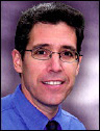Last week, I attended the opening of Alien Technology’s RFID Solution Center in Dayton, Ohio (see Alien Opens Dayton RFID Lab). Alien and the state of Ohio deserve kudos for investing in the state-of-the-art facility, but what’s most encouraging to me is that the lab is a rare example of a private company, government and academia working together to take RFID forward.
The RFID Solutions Center has enlisted the cooperation of five area universities, which will use the center for teaching, research and development. This kind of cooperation between industry, government and academia is going to be crucial if we are to solve the many implementation problems that still exist and develop solutions that transform the way companies manufacture, distribute and sell product.
|
|
I first started thinking about the need for a more coordinated approach to research about 18 months ago. I’d been traveling around the United States and the world to attend events and write stories on innovative projects. Along the way, I met several academics doing interesting applied research. Few of them knew of each other, and almost no end users knew this research was going on. That was crazy.
So I approached Bill Hardgrave, director of the RFID Research Center at the University of Arkansas; Steve Miles, a research engineer at the Auto-ID Labs at MIT; Dan Deavours, director of research at the RFID Alliance Lab and the University of Kansas; and others. I suggested we hold an academic conference to share research papers, network and educate end users about the work they were doing.
Everyone thought it was a great idea. Miles, Hardgrave and others formed a committee, which took the ball and ran with it. The result was the first RFID Academic Convocation, held at MIT last month (see MIT to Host RFID Academic Convocation).
It was a huge success. Not only did it draw academics from around the world, it also was attended by thought leaders from a variety of industries. I had the privilege of hosting a panel that included Dick Cantwell, vice president of Procter & Gamble/Gillette; Claus Garbisch, sector head/consumer and retail for DHL Logistics; Simon Langford, director of RFID strategy for Wal-Mart Stores; and Michael Rose, vice president of RFID/EPCglobal value chain at Johnson & Johnson.
The convocation identified research projects requiring hundreds of millions of dollars in research funds. Where is that money going to come from? Some of it will come from governments. The European Union has put up nearly $10 million to fund the Promise project, which is looking at ways to use RFID for product lifecycle management. Asian countries have put up tens of millions of dollars to promote research in RFID. The United States federal government, despite the military’s push to adopt the technology, has done very little. States like Ohio and North Dakota are doing what they can.
The vast majority of funding will have to come from companies, and we’ve seen some visionary firms taking the lead. Airplane makers Airbus, Boeing and Embraer, as well as defense company BAE Systems, are supporting the Aero-ID Programme run by the Auto-ID Labs at Cambridge. Wal-Mart and others, meanwhile, are supporting the RFID Research Center at the University of Arkansas. But this is a drop in the proverbial bucket.
I understand that companies are not going to fund research out of a love for academics. The academics understand that, too. Research has to be applied toward solving the deployment issues end users face, or toward finding new ways to improve the way companies do business. The RFID Academic Convocation organizing committee plans to hold a second event, in conjunction with RFID Journal LIVE! (May 1-3) to identify what research needs to be done, and to begin creating a plan for coordinating research activities with the joint aim of solving problems and creating value for end users of the technology. Once a plan is complete, the researchers can raise funding by showing companies that the academic research they invest in will provide real value for them and their industry.
The academic community is doing its part. I hope companies and industry organizations will step up and do theirs by supporting applied research and moving RFID forward. Given the competing demands for funds, however, I’m not completely confident that will happen. Even end users understand that industry is not doing enough. During a break at the opening of the Alien facility, an end user came up to me and said: “Impressive facility, but it shouldn’t be up to Alien to fund this kind of thing. It should be industry investing in the future.”
I could not agree more.
Mark Roberti is the founder and editor of RFID Journal. If you would like to comment on this article, click on the link below.


